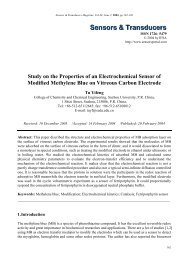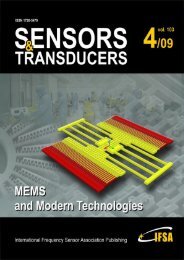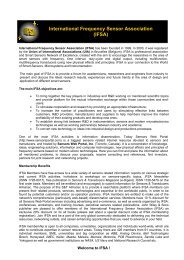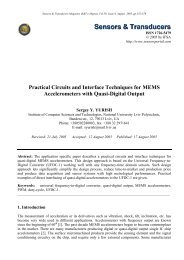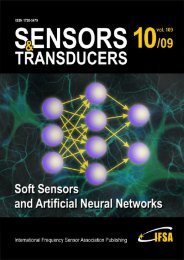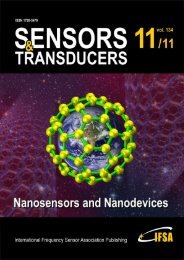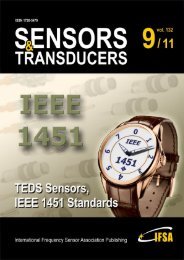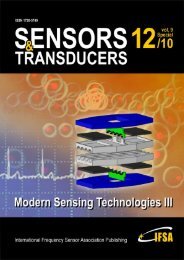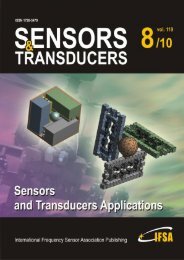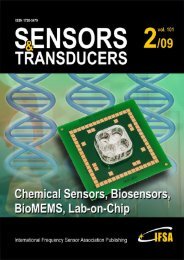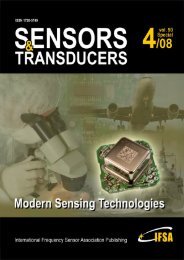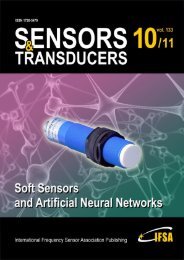A Novel Hall Effect Sensor Using Elaborate Offset Cancellation ...
A Novel Hall Effect Sensor Using Elaborate Offset Cancellation ...
A Novel Hall Effect Sensor Using Elaborate Offset Cancellation ...
You also want an ePaper? Increase the reach of your titles
YUMPU automatically turns print PDFs into web optimized ePapers that Google loves.
<strong>Sensor</strong>s & Transducers<br />
Volume 100<br />
January 2009<br />
www.sensorsportal.com ISSN 1726-5479<br />
Editor-in-Chief: professor Sergey Y. Yurish, phone: +34 696067716, fax: +34 93 4011989, e-mail: editor@sensorsportal.com<br />
Editors for Western Europe<br />
Meijer, Gerard C.M., Delft University of Technology, The Netherlands<br />
Ferrari, Vittorio, Universitá di Brescia, Italy<br />
Editors for North America<br />
Datskos, Panos G., Oak Ridge National Laboratory, USA<br />
Fabien, J. Josse, Marquette University, USA<br />
Katz, Evgeny, Clarkson University, USA<br />
Abdul Rahim, Ruzairi, Universiti Teknologi, Malaysia<br />
Ahmad, Mohd Noor, Nothern University of Engineering, Malaysia<br />
Annamalai, Karthigeyan, National Institute of Advanced Industrial Science<br />
and Technology, Japan<br />
Arcega, Francisco, University of Zaragoza, Spain<br />
Arguel, Philippe, CNRS, France<br />
Ahn, Jae-Pyoung, Korea Institute of Science and Technology, Korea<br />
Arndt, Michael, Robert Bosch GmbH, Germany<br />
Ascoli, Giorgio, George Mason University, USA<br />
Atalay, Selcuk, Inonu University, Turkey<br />
Atghiaee, Ahmad, University of Tehran, Iran<br />
Augutis, Vygantas, Kaunas University of Technology, Lithuania<br />
Avachit, Patil Lalchand, North Maharashtra University, India<br />
Ayesh, Aladdin, De Montfort University, UK<br />
Bahreyni, Behraad, University of Manitoba, Canada<br />
Baoxian, Ye, Zhengzhou University, China<br />
Barford, Lee, Agilent Laboratories, USA<br />
Barlingay, Ravindra, RF Arrays Systems, India<br />
Basu, Sukumar, Jadavpur University, India<br />
Beck, Stephen, University of Sheffield, UK<br />
Ben Bouzid, Sihem, Institut National de Recherche Scientifique, Tunisia<br />
Benachaiba, Chellali, Universitaire de Bechar, Algeria<br />
Binnie, T. David, Napier University, UK<br />
Bischoff, Gerlinde, Inst. Analytical Chemistry, Germany<br />
Bodas, Dhananjay, IMTEK, Germany<br />
Borges Carval, Nuno, Universidade de Aveiro, Portugal<br />
Bousbia-Salah, Mounir, University of Annaba, Algeria<br />
Bouvet, Marcel, CNRS – UPMC, France<br />
Brudzewski, Kazimierz, Warsaw University of Technology, Poland<br />
Cai, Chenxin, Nanjing Normal University, China<br />
Cai, Qingyun, Hunan University, China<br />
Campanella, Luigi, University La Sapienza, Italy<br />
Carvalho, Vitor, Minho University, Portugal<br />
Cecelja, Franjo, Brunel University, London, UK<br />
Cerda Belmonte, Judith, Imperial College London, UK<br />
Chakrabarty, Chandan Kumar, Universiti Tenaga Nasional, Malaysia<br />
Chakravorty, Dipankar, Association for the Cultivation of Science, India<br />
Changhai, Ru, Harbin Engineering University, China<br />
Chaudhari, Gajanan, Shri Shivaji Science College, India<br />
Chen, Jiming, Zhejiang University, China<br />
Chen, Rongshun, National Tsing Hua University, Taiwan<br />
Cheng, Kuo-Sheng, National Cheng Kung University, Taiwan<br />
Chiang, Jeffrey (Cheng-Ta), Industrial Technol. Research Institute, Taiwan<br />
Chiriac, Horia, National Institute of Research and Development, Romania<br />
Chowdhuri, Arijit, University of Delhi, India<br />
Chung, Wen-Yaw, Chung Yuan Christian University, Taiwan<br />
Corres, Jesus, Universidad Publica de Navarra, Spain<br />
Cortes, Camilo A., Universidad Nacional de Colombia, Colombia<br />
Courtois, Christian, Universite de Valenciennes, France<br />
Cusano, Andrea, University of Sannio, Italy<br />
D'Amico, Arnaldo, Università di Tor Vergata, Italy<br />
De Stefano, Luca, Institute for Microelectronics and Microsystem, Italy<br />
Deshmukh, Kiran, Shri Shivaji Mahavidyalaya, Barshi, India<br />
Dickert, Franz L., Vienna University, Austria<br />
Dieguez, Angel, University of Barcelona, Spain<br />
Dimitropoulos, Panos, University of Thessaly, Greece<br />
Ding Jian, Ning, Jiangsu University, China<br />
Djordjevich, Alexandar, City University of Hong Kong, Hong Kong<br />
Ko, Sang Choon, Electronics and Telecommunications Research Institute,<br />
Editorial Advisory Board<br />
Editor South America<br />
Costa-Felix, Rodrigo, Inmetro, Brazil<br />
Editor for Eastern Europe<br />
Sachenko, Anatoly, Ternopil State Economic University, Ukraine<br />
Editor for Asia<br />
Ohyama, Shinji, Tokyo Institute of Technology, Japan<br />
Donato, Nicola, University of Messina, Italy<br />
Donato, Patricio, Universidad de Mar del Plata, Argentina<br />
Dong, Feng, Tianjin University, China<br />
Drljaca, Predrag, Instersema <strong>Sensor</strong>ic SA, Switzerland<br />
Dubey, Venketesh, Bournemouth University, UK<br />
Enderle, Stefan, University of Ulm and KTB Mechatronics GmbH,<br />
Germany<br />
Erdem, Gursan K. Arzum, Ege University, Turkey<br />
Erkmen, Aydan M., Middle East Technical University, Turkey<br />
Estelle, Patrice, Insa Rennes, France<br />
Estrada, Horacio, University of North Carolina, USA<br />
Faiz, Adil, INSA Lyon, France<br />
Fericean, Sorin, Balluff GmbH, Germany<br />
Fernandes, Joana M., University of Porto, Portugal<br />
Francioso, Luca, CNR-IMM Institute for Microelectronics and<br />
Microsystems, Italy<br />
Francis, Laurent, University Catholique de Louvain, Belgium<br />
Fu, Weiling, South-Western Hospital, Chongqing, China<br />
Gaura, Elena, Coventry University, UK<br />
Geng, Yanfeng, China University of Petroleum, China<br />
Gole, James, Georgia Institute of Technology, USA<br />
Gong, Hao, National University of Singapore, Singapore<br />
Gonzalez de la Rosa, Juan Jose, University of Cadiz, Spain<br />
Granel, Annette, Goteborg University, Sweden<br />
Graff, Mason, The University of Texas at Arlington, USA<br />
Guan, Shan, Eastman Kodak, USA<br />
Guillet, Bruno, University of Caen, France<br />
Guo, Zhen, New Jersey Institute of Technology, USA<br />
Gupta, Narendra Kumar, Napier University, UK<br />
Hadjiloucas, Sillas, The University of Reading, UK<br />
Hashsham, Syed, Michigan State University, USA<br />
Hernandez, Alvaro, University of Alcala, Spain<br />
Hernandez, Wilmar, Universidad Politecnica de Madrid, Spain<br />
Homentcovschi, Dorel, SUNY Binghamton, USA<br />
Horstman, Tom, U.S. Automation Group, LLC, USA<br />
Hsiai, Tzung (John), University of Southern California, USA<br />
Huang, Jeng-Sheng, Chung Yuan Christian University, Taiwan<br />
Huang, Star, National Tsing Hua University, Taiwan<br />
Huang, Wei, PSG Design Center, USA<br />
Hui, David, University of New Orleans, USA<br />
Jaffrezic-Renault, Nicole, Ecole Centrale de Lyon, France<br />
Jaime Calvo-Galleg, Jaime, Universidad de Salamanca, Spain<br />
James, Daniel, Griffith University, Australia<br />
Janting, Jakob, DELTA Danish Electronics, Denmark<br />
Jiang, Liudi, University of Southampton, UK<br />
Jiang, Wei, University of Virginia, USA<br />
Jiao, Zheng, Shanghai University, China<br />
John, Joachim, IMEC, Belgium<br />
Kalach, Andrew, Voronezh Institute of Ministry of Interior, Russia<br />
Kang, Moonho, Sunmoon University, Korea South<br />
Kaniusas, Eugenijus, Vienna University of Technology, Austria<br />
Katake, Anup, Texas A&M University, USA<br />
Kausel, Wilfried, University of Music, Vienna, Austria<br />
Kavasoglu, Nese, Mugla University, Turkey<br />
Ke, Cathy, Tyndall National Institute, Ireland<br />
Khan, Asif, Aligarh Muslim University, Aligarh, India<br />
Kim, Min Young, Koh Young Technology, Inc., Korea South<br />
Sandacci, Serghei, <strong>Sensor</strong> Technology Ltd., UK<br />
Sapozhnikova, Ksenia, D.I.Mendeleyev Institute for Metrology, Russia
Korea South<br />
Kockar, Hakan, Balikesir University, Turkey<br />
Kotulska, Malgorzata, Wroclaw University of Technology, Poland<br />
Kratz, Henrik, Uppsala University, Sweden<br />
Kumar, Arun, University of South Florida, USA<br />
Kumar, Subodh, National Physical Laboratory, India<br />
Kung, Chih-Hsien, Chang-Jung Christian University, Taiwan<br />
Lacnjevac, Caslav, University of Belgrade, Serbia<br />
Lay-Ekuakille, Aime, University of Lecce, Italy<br />
Lee, Jang Myung, Pusan National University, Korea South<br />
Lee, Jun Su, Amkor Technology, Inc. South Korea<br />
Lei, Hua, National Starch and Chemical Company, USA<br />
Li, Genxi, Nanjing University, China<br />
Li, Hui, Shanghai Jiaotong University, China<br />
Li, Xian-Fang, Central South University, China<br />
Liang, Yuanchang, University of Washington, USA<br />
Liawruangrath, Saisunee, Chiang Mai University, Thailand<br />
Liew, Kim Meow, City University of Hong Kong, Hong Kong<br />
Lin, Hermann, National Kaohsiung University, Taiwan<br />
Lin, Paul, Cleveland State University, USA<br />
Linderholm, Pontus, EPFL - Microsystems Laboratory, Switzerland<br />
Liu, Aihua, University of Oklahoma, USA<br />
Liu Changgeng, Louisiana State University, USA<br />
Liu, Cheng-Hsien, National Tsing Hua University, Taiwan<br />
Liu, Songqin, Southeast University, China<br />
Lodeiro, Carlos, Universidade NOVA de Lisboa, Portugal<br />
Lorenzo, Maria Encarnacio, Universidad Autonoma de Madrid, Spain<br />
Lukaszewicz, Jerzy Pawel, Nicholas Copernicus University, Poland<br />
Ma, Zhanfang, Northeast Normal University, China<br />
Majstorovic, Vidosav, University of Belgrade, Serbia<br />
Marquez, Alfredo, Centro de Investigacion en Materiales Avanzados,<br />
Mexico<br />
Matay, Ladislav, Slovak Academy of Sciences, Slovakia<br />
Mathur, Prafull, National Physical Laboratory, India<br />
Maurya, D.K., Institute of Materials Research and Engineering, Singapore<br />
Mekid, Samir, University of Manchester, UK<br />
Melnyk, Ivan, Photon Control Inc., Canada<br />
Mendes, Paulo, University of Minho, Portugal<br />
Mennell, Julie, Northumbria University, UK<br />
Mi, Bin, Boston Scientific Corporation, USA<br />
Minas, Graca, University of Minho, Portugal<br />
Moghavvemi, Mahmoud, University of Malaya, Malaysia<br />
Mohammadi, Mohammad-Reza, University of Cambridge, UK<br />
Molina Flores, Esteban, Benemérita Universidad Autónoma de Puebla,<br />
Mexico<br />
Moradi, Majid, University of Kerman, Iran<br />
Morello, Rosario, DIMET, University "Mediterranea" of Reggio Calabria,<br />
Italy<br />
Mounir, Ben Ali, University of Sousse, Tunisia<br />
Mukhopadhyay, Subhas, Massey University, New Zealand<br />
Neelamegam, Periasamy, Sastra Deemed University, India<br />
Neshkova, Milka, Bulgarian Academy of Sciences, Bulgaria<br />
Oberhammer, Joachim, Royal Institute of Technology, Sweden<br />
Ould Lahoucine, Cherif, University of Guelma, Algeria<br />
Pamidighanta, Sayanu, Bharat Electronics Limited (BEL), India<br />
Pan, Jisheng, Institute of Materials Research & Engineering, Singapore<br />
Park, Joon-Shik, Korea Electronics Technology Institute, Korea South<br />
Penza, Michele, ENEA C.R., Italy<br />
Pereira, Jose Miguel, Instituto Politecnico de Setebal, Portugal<br />
Petsev, Dimiter, University of New Mexico, USA<br />
Pogacnik, Lea, University of Ljubljana, Slovenia<br />
Post, Michael, National Research Council, Canada<br />
Prance, Robert, University of Sussex, UK<br />
Prasad, Ambika, Gulbarga University, India<br />
Prateepasen, Asa, Kingmoungut's University of Technology, Thailand<br />
Pullini, Daniele, Centro Ricerche FIAT, Italy<br />
Pumera, Martin, National Institute for Materials Science, Japan<br />
Radhakrishnan, S. National Chemical Laboratory, Pune, India<br />
Rajanna, K., Indian Institute of Science, India<br />
Ramadan, Qasem, Institute of Microelectronics, Singapore<br />
Rao, Basuthkar, Tata Inst. of Fundamental Research, India<br />
Raoof, Kosai, Joseph Fourier University of Grenoble, France<br />
Reig, Candid, University of Valencia, Spain<br />
Restivo, Maria Teresa, University of Porto, Portugal<br />
Robert, Michel, University Henri Poincare, France<br />
Rezazadeh, Ghader, Urmia University, Iran<br />
Royo, Santiago, Universitat Politecnica de Catalunya, Spain<br />
Rodriguez, Angel, Universidad Politecnica de Cataluna, Spain<br />
Rothberg, Steve, Loughborough University, UK<br />
Sadana, Ajit, University of Mississippi, USA<br />
Sadeghian Marnani, Hamed, TU Delft, The Netherlands<br />
Saxena, Vibha, Bhbha Atomic Research Centre, Mumbai, India<br />
Schneider, John K., Ultra-Scan Corporation, USA<br />
Seif, Selemani, Alabama A & M University, USA<br />
Seifter, Achim, Los Alamos National Laboratory, USA<br />
Sengupta, Deepak, Advance Bio-Photonics, India<br />
Shankar, B. Baliga, General Monitors Transnational, USA<br />
Shearwood, Christopher, Nanyang Technological University, Singapore<br />
Shin, Kyuho, Samsung Advanced Institute of Technology, Korea<br />
Shmaliy, Yuriy, Kharkiv National University of Radio Electronics,<br />
Ukraine<br />
Silva Girao, Pedro, Technical University of Lisbon, Portugal<br />
Singh, V. R., National Physical Laboratory, India<br />
Slomovitz, Daniel, UTE, Uruguay<br />
Smith, Martin, Open University, UK<br />
Soleymanpour, Ahmad, Damghan Basic Science University, Iran<br />
Somani, Prakash R., Centre for Materials for Electronics Technol., India<br />
Srinivas, Talabattula, Indian Institute of Science, Bangalore, India<br />
Srivastava, Arvind K., Northwestern University, USA<br />
Stefan-van Staden, Raluca-Ioana, University of Pretoria, South Africa<br />
Sumriddetchka, Sarun, National Electronics and Computer Technology<br />
Center, Thailand<br />
Sun, Chengliang, Polytechnic University, Hong-Kong<br />
Sun, Dongming, Jilin University, China<br />
Sun, Junhua, Beijing University of Aeronautics and Astronautics, China<br />
Sun, Zhiqiang, Central South University, China<br />
Suri, C. Raman, Institute of Microbial Technology, India<br />
Sysoev, Victor, Saratov State Technical University, Russia<br />
Szewczyk, Roman, Industrial Research Institute for Automation and<br />
Measurement, Poland<br />
Tan, Ooi Kiang, Nanyang Technological University, Singapore,<br />
Tang, Dianping, Southwest University, China<br />
Tang, Jaw-Luen, National Chung Cheng University, Taiwan<br />
Teker, Kasif, Frostburg State University, USA<br />
Thumbavanam Pad, Kartik, Carnegie Mellon University, USA<br />
Tian, Gui Yun, University of Newcastle, UK<br />
Tsiantos, Vassilios, Technological Educational Institute of Kaval, Greece<br />
Tsigara, Anna, National Hellenic Research Foundation, Greece<br />
Twomey, Karen, University College Cork, Ireland<br />
Valente, Antonio, University, Vila Real, - U.T.A.D., Portugal<br />
Vaseashta, Ashok, Marshall University, USA<br />
Vazquez, Carmen, Carlos III University in Madrid, Spain<br />
Vieira, Manuela, Instituto Superior de Engenharia de Lisboa, Portugal<br />
Vigna, Benedetto, STMicroelectronics, Italy<br />
Vrba, Radimir, Brno University of Technology, Czech Republic<br />
Wandelt, Barbara, Technical University of Lodz, Poland<br />
Wang, Jiangping, Xi'an Shiyou University, China<br />
Wang, Kedong, Beihang University, China<br />
Wang, Liang, Advanced Micro Devices, USA<br />
Wang, Mi, University of Leeds, UK<br />
Wang, Shinn-Fwu, Ching Yun University, Taiwan<br />
Wang, Wei-Chih, University of Washington, USA<br />
Wang, Wensheng, University of Pennsylvania, USA<br />
Watson, Steven, Center for NanoSpace Technologies Inc., USA<br />
Weiping, Yan, Dalian University of Technology, China<br />
Wells, Stephen, Southern Company Services, USA<br />
Wolkenberg, Andrzej, Institute of Electron Technology, Poland<br />
Woods, R. Clive, Louisiana State University, USA<br />
Wu, DerHo, National Pingtung University of Science and Technology,<br />
Taiwan<br />
Wu, Zhaoyang, Hunan University, China<br />
Xiu Tao, Ge, Chuzhou University, China<br />
Xu, Lisheng, The Chinese University of Hong Kong, Hong Kong<br />
Xu, Tao, University of California, Irvine, USA<br />
Yang, Dongfang, National Research Council, Canada<br />
Yang, Wuqiang, The University of Manchester, UK<br />
Ymeti, Aurel, University of Twente, Netherland<br />
Yong Zhao, Northeastern University, China<br />
Yu, Haihu, Wuhan University of Technology, China<br />
Yuan, Yong, Massey University, New Zealand<br />
Yufera Garcia, Alberto, Seville University, Spain<br />
Zagnoni, Michele, University of Southampton, UK<br />
Zeni, Luigi, Second University of Naples, Italy<br />
Zhong, Haoxiang, Henan Normal University, China<br />
Zhang, Minglong, Shanghai University, China<br />
Zhang, Qintao, University of California at Berkeley, USA<br />
Zhang, Weiping, Shanghai Jiao Tong University, China<br />
Zhang, Wenming, Shanghai Jiao Tong University, China<br />
Zhou, Zhi-Gang, Tsinghua University, China<br />
Zorzano, Luis, Universidad de La Rioja, Spain<br />
Zourob, Mohammed, University of Cambridge, UK<br />
<strong>Sensor</strong>s & Transducers Journal (ISSN 1726-5479) is a peer review international journal published monthly online by International Frequency <strong>Sensor</strong> Association (IFSA).<br />
Available in electronic and CD-ROM. Copyright © 2009 by International Frequency <strong>Sensor</strong> Association. All rights reserved.
<strong>Sensor</strong>s & Transducers Journal<br />
Contents<br />
Volume 100<br />
Issue 1<br />
January 2009<br />
www.sensorsportal.com ISSN 1726-5479<br />
Editorial<br />
International Frequency <strong>Sensor</strong> Association (IFSA) Celebrates the 10 th Anniversary .............<br />
Sergey Y. Yurish<br />
I<br />
Research Articles<br />
A Log Amplifier Based Linearization Scheme for Thermocouples<br />
Nikhil Mondal, A. Abudhahir, Sourav Kanti Jana,Sugata Munshi and D. P. Bhattacharya................ 1<br />
Uncertainty Analysis of Thermocouple Circuits<br />
B. Vasuki, M. Umapathy, S. K. Velumani ........................................................................................... 11<br />
Calibration System for Thermocouple Testing<br />
Dragan R. Milivojevic, Visa Tasic, Marijana Pavlov, Zoran Andjelkovic ............................................. 16<br />
Embedded Processor Based Automatic Temperature Control of VLSI Chips<br />
Narasimha Murthy Yayavaram, Saritha Chappidi, Sukanya Velamakuri........................................... 27<br />
Field of Temperature Measurement by Virtual Instrumentation<br />
Libor Hargaš, Dušan Koniar, Miroslav Hrianka, Jozef Čuntala .......................................................... 45<br />
Analyzing Electroencephalogram Signal <strong>Using</strong> EEG Lab<br />
Mukesh Bhardwaj and Avtar. K. Nadir ............................................................................................... 51<br />
New Aspects in Respiratory Epithelium Diagnostics <strong>Using</strong> Virtual Instrumentation<br />
Dušan Koniar, Libor Hargaš, Miroslav Hrianka, Peter Bánovčin........................................................ 58<br />
A PC-based Technique to Measure the Thermal Conductivity of Solid Materials<br />
Alety Sridevireddy, K. Raghavendra Rao........................................................................................... 65<br />
A New Wide Frequency Band Capacitance Transducer with Application to Measuring Metal<br />
Fill Time<br />
Wael Deabes, Mohamed Abdelrahman, and Periasamy K. Rajan .................................................... 72<br />
A <strong>Novel</strong> <strong>Hall</strong> <strong>Effect</strong> <strong>Sensor</strong> <strong>Using</strong> <strong>Elaborate</strong> <strong>Offset</strong> <strong>Cancellation</strong> Method<br />
Vlassis N. Petoussis, Panos D. Dimitropoulos and George Stamoulis.............................................. 85<br />
A Review of Material Properties Estimation <strong>Using</strong> Eddy Current Testing and Capacitor<br />
Imaging<br />
Mohd. Amri Yunus, S. C. Mukhopadhyay and G. Sen Gupta ............................................................ 92<br />
Surface Plasmon Resonance Based Fiber Optic <strong>Sensor</strong> with Symmetric and Asymmetric<br />
Metallic Coatings: a Comparative Study<br />
Smita Singh, Rajneesh K. Verma and B. D. Gupta............................................................................ 116
Increasing of Excursion Range of Absolute Optical <strong>Sensor</strong>s Intended for Positioners<br />
Igor Friedland, Ioseph Gurwich, Amit Brandes................................................................................... 125<br />
Field-<strong>Effect</strong>-Transistor Behavior of a Multiwall Carbon Nano Fiber Directly Grown on Nickel<br />
Electrodes<br />
L. W. Chang, P. S. Wu, J. T. Lue and Z. P. Chen.............................................................................. 137<br />
Classification of Fiber-Optic Pressure <strong>Sensor</strong>s with Amplitude Modulation of Optical Signal<br />
Vladyslav Kondratov, Vitalii Redko..................................................................................................... 146<br />
New e-Book<br />
Laboratories of Instrumentation for Measurement<br />
Maria Teresa Restivo, Fernando Gomes de Almeida, Maria de Fátima Chouzal, Joaquim Gabriel<br />
Mendes, António Mendes Lopes........................................................................................................ 161<br />
Authors are encouraged to submit article in MS Word (doc) and Acrobat (pdf) formats by e-mail: editor@sensorsportal.com<br />
Please visit journal’s webpage with preparation instructions: http://www.sensorsportal.com/HTML/DIGEST/Submition.htm<br />
International Frequency <strong>Sensor</strong> Association (IFSA).
<strong>Sensor</strong>s & Transducers Journal, Vol. 100, Issue 1, January 2009, pp. 85-91<br />
<strong>Sensor</strong>s & Transducers<br />
ISSN 1726-5479<br />
© 2009 by IFSA<br />
http://www.sensorsportal.com<br />
A <strong>Novel</strong> <strong>Hall</strong> <strong>Effect</strong> <strong>Sensor</strong> <strong>Using</strong> <strong>Elaborate</strong><br />
<strong>Offset</strong> <strong>Cancellation</strong> Method<br />
Vlassis N. Petoussis, Panos D. Dimitropoulos and George Stamoulis<br />
University of Thessaly. Department of Computer & Communication Engineering<br />
Tel.: +30 24210 66594, e-mail: petousis@inf.uth.gr<br />
Received: 18 December 2008 /Accepted: 19 January 2009 /Published: 26 January 2009<br />
Abstract: The <strong>Hall</strong> effect is caused by a traverse force that is formed in the electrons or holes of metal<br />
element or semiconductor when are polarized by current source and simultaneously all the system it is<br />
found vertical in external magnetic field. Result is finally the production of difference of potential<br />
(<strong>Hall</strong> voltage) in address vertical in that of current and magnetic field directions. In the present work is<br />
presented a new <strong>Hall</strong> sensor exploiting the former operation. In combination with his pioneering form<br />
and using dynamic spinning current technique with an elaborate sequence, it leads to satisfactory<br />
results of produced <strong>Hall</strong> voltage with small noise in a presence of external magnetic field. Anyone can<br />
see both the spinning current and anti-<strong>Hall</strong> technique in the same sensor simultaneously.<br />
Copyright © 2009 IFSA.<br />
Keywords: <strong>Hall</strong> plate, Magnetic sensor, Dynamic offset reduction, Wheel hall sensor<br />
1. Introduction<br />
<strong>Hall</strong> plates are used in a wide variety of applications to measure static and dynamic magnetic fields. A<br />
major drawback of these sensors is their high offset voltage, i.e., an output signal in the absence of a<br />
magnetic induction. According to [1] the effects which contribute to the offset voltage are<br />
piezoresistive effects, geometrical errors, temperature gradients, nonhomogeneities, etc. However, the<br />
offset voltage with a spatially periodic nature differs from the <strong>Hall</strong> voltage, which is constant. One way<br />
to reduce the offset caused by orthogonal asymmetries is to use coupled symmetric <strong>Hall</strong> plates [2].<br />
However, the offset can never be completely cancelled because there will always be small differences<br />
between the <strong>Hall</strong> devices. To overcome the mismatch, the bias current of a single four contact <strong>Hall</strong><br />
device is spun by contact commutating and the resulting output voltages are averaged over time. The<br />
orientation dependence of the offset sources in silicon suggests that orthogonal switching is not<br />
85
<strong>Sensor</strong>s & Transducers Journal, Vol. 100, Issue 1, January 2009, pp. 85-91<br />
sufficient. To cancel components of higher asymmetries a multicontact <strong>Hall</strong> plate with more than four<br />
terminals is necessary. The method presented in this paper is based on <strong>Hall</strong> device with sixteen outside<br />
and sixteen inside contacts. The spinning current vector is generated by two harmonic biasing currents.<br />
As a result, the output signal becomes spatially continuously accessible, hence, asymmetries of higher<br />
order can be cancelled out.<br />
Aim of present work is the presentation of new <strong>Hall</strong> sensor with pioneering form that reminds<br />
cogwheel with two lines teeth, one internally and one externally (for this reason we named Wheel <strong>Hall</strong><br />
<strong>Sensor</strong>) but also with different way in the cancellation of offset voltage and finally 1/f noise rejection.<br />
Initially the designing constituted fundamental objective that as aim had the respect and compatibility<br />
in the existing techniques of reduction 1/f noise and also offset voltage. For this aim was selected the<br />
circular structure (Fig. 3) but with the differentiation, that the interior of circle is empty from material<br />
and besides is not unexploited but constitutes part region of expiry of <strong>Hall</strong> voltage with periodical<br />
phase of operation.<br />
2. <strong>Hall</strong> Type Devices (without <strong>Offset</strong>)<br />
The simplest <strong>Hall</strong> element uses a square plate of N-well in a p-type epitaxial layer. Each corner of the<br />
plate has one contact. When a voltage V C is supplied across one pair of contacts, then a magnetic field<br />
B perpendicular to the <strong>Hall</strong> plate generates a voltage V H across the sensing pair of contacts according<br />
to:<br />
V<br />
= S V B (for Voltage bias) (1)<br />
H H C<br />
V = H<br />
I<br />
biasSB<br />
(for Current bias), (2)<br />
where S H represents de sensitivity of the <strong>Hall</strong> plate in mV/VT.<br />
(a)<br />
(b)<br />
Fig. 1. Basic <strong>Hall</strong>-sensor structure: with voltage bias (a) and with current bias (b).<br />
Typical sensitivities of <strong>Hall</strong> plates fabricated in standard CMOS technology are in the order of<br />
100 mV/VT. Most applications require magnetic field strengths to be measured in the signal range of<br />
40 µT (earth-magnetic field) up to 250 mT (strong magnet). It is the lower end of this range that make<br />
the use of CMOS <strong>Hall</strong> sensors very difficult. The main problem for realizing a low-cost compass using<br />
silicon <strong>Hall</strong> sensors is its offset and, even more important, the drift of the sensor offset. Commercially<br />
86
<strong>Sensor</strong>s & Transducers Journal, Vol. 100, Issue 1, January 2009, pp. 85-91<br />
available <strong>Hall</strong> sensors typically operate over ranges that start at 1mT and have noise levels in the order<br />
of 50-100 µT.<br />
3. <strong>Hall</strong> Type Devices (With <strong>Offset</strong>)<br />
Made in a standard IC process <strong>Hall</strong> plates have the advantage of cheap and small. Therefore they are<br />
quite often used in applications where the permanent magnet is combined with the sensor. Because<br />
<strong>Hall</strong> plates show a large offset the magnet used in these applications have to be a strong magnets. The<br />
offset of the <strong>Hall</strong> plate is the voltage that is measured when no magnetic field is applied. Equation 2<br />
represents the theoretical situation, when an offset is added this equation becomes:<br />
V = I SB + V<br />
(3)<br />
H<br />
bias<br />
offset<br />
To reduce the offset, which is time variant, spinning current <strong>Hall</strong> plates was developed [3]. These are<br />
symmetrical <strong>Hall</strong> plates with 4,8,16 or more contacts. In this multi contact <strong>Hall</strong> plates the bias current<br />
is switched in for example, eight directions through the <strong>Hall</strong> plate and the corresponding voltages are<br />
measured, see Fig. 2. [4]<br />
Fig. 2. An eight contact spinning-current <strong>Hall</strong> plate with the possible bias current directions.<br />
The measured voltages represent one period of a (radial spatial) periodic signal. The spinning current<br />
method uses this periodicity, it separates transduction effects according to their spatial radial<br />
periodicity. From the output signal a Fourier transform is calculated. The <strong>Hall</strong> effect itself does not<br />
depend on bias current direction and is therefore present in the DC component. <strong>Offset</strong> voltages that<br />
contribute to the higher Fourier coefficients are eliminated. So, a spinning-current <strong>Hall</strong> plate solves<br />
one of the most important drawbacks in integrated silicon <strong>Hall</strong> plates: their offset. But it involves more<br />
interface electronics to realize the sensor on one chip.<br />
4. Wheel <strong>Hall</strong> <strong>Sensor</strong> (WHS) Device Structure<br />
In university of Thessaly we designed and we are ready to develop a novel <strong>Hall</strong> sensor device which<br />
uses elaborate spinning current technique. The novel <strong>Hall</strong> device that we call “Wheel <strong>Hall</strong> Senor” is<br />
presented in Figs. 3a and 3b. The current enters the device, as presented in the aforementioned figures,<br />
in two phases namely the even phase (PHASE-P) and the odd phase (PHASE-N).<br />
87
<strong>Sensor</strong>s & Transducers Journal, Vol. 100, Issue 1, January 2009, pp. 85-91<br />
(a)<br />
(b)<br />
Fig. 3. The novel <strong>Hall</strong> device that we call “Wheel <strong>Hall</strong> Senor” or WHS:<br />
(a) The even phase (PHASE-P); (b) the odd phase (PHASE-N).<br />
The device exploits the signals attributed to <strong>Hall</strong> voltage, <strong>Hall</strong> current and geometric MR effect. As a<br />
result the device is equivalent to an “ideal” voltage or current <strong>Hall</strong> sensor with geometrical factor of<br />
one (G H = 1). Moreover it provides for high-speed spinning, given that the voltage distribution changes<br />
moderately between different phases. This is equivalent to minimum charge injection that 0 in turn –<br />
allows spinning frequency increase. The device senses all 3 filed dimensions, namely the flux-density<br />
of B Z is proportional to the DC component of the output signal, whereas the B X and B Y components are<br />
proportional to the first harmonic of the output signal. Finally the device can be made in a way to reuse<br />
the current, if integrated in a BiCMOS technology providing for matched JFETs.<br />
5. Wheel <strong>Hall</strong> <strong>Sensor</strong> (WHS) Device. <strong>Offset</strong> Reduction - Theory<br />
To reduce the offset, the spinning-current <strong>Hall</strong> plate may be developed in SPICE-like EDA simulators<br />
(CADENCE). A spinning-current <strong>Hall</strong> plate is a symmetrical <strong>Hall</strong> plate in which the direction of the<br />
bias current is spited right and left and the corresponding output voltage is measured on the contacts in<br />
±45º to the current direction in each phase. The total number of measurements at each phase is in four<br />
places like a cross and all phases give as the total <strong>Hall</strong> voltage. When sixteen outside and sixteen<br />
inside contacts are used, the bias current is switched ±45º for each measurement, the voltage contacts<br />
are switched outside to inside respectively (Fig. 4). For each phase of the bias current, four output (V H+<br />
and V H- ) and input (V H- and V H+ ) voltages are measured in a rotating clock wise. Finally for each turn<br />
in PHASE-P and PHASE-N, totally sixteen <strong>Hall</strong> voltages are measured (Fig. 5). Each harmonic<br />
biasing current in each phase produces an offset voltage witch totally in turns gives us the offset<br />
cancellation. So offset caused from current I AD in phase P cancel the offset caused from current I CD in<br />
phase N and I AD in phase N cancel the offset caused from current I AF in phase P. Finally the one offset<br />
in one phase cancel the other in next phase. Anyone can see both the spinning current and anti-<strong>Hall</strong><br />
technique in the same sensor simultaneously [5], [6].<br />
6. Electronic Circuitry<br />
To control the spinning-current <strong>Hall</strong> plate we need:<br />
1. A current source to generate the bias current;<br />
88
<strong>Sensor</strong>s & Transducers Journal, Vol. 100, Issue 1, January 2009, pp. 85-91<br />
2. Current switches to connect the bias current source to the right contacts of the spinning-current <strong>Hall</strong><br />
plate;<br />
3. Voltages switches to connect the right measure contacts of the spinning-current <strong>Hall</strong> plate to the<br />
amplifiers;<br />
4. Amplifiers;<br />
5. Analog-to-digital converter.<br />
(a)<br />
(b)<br />
Fig. 4. The even phases (a) and the odd phases (b). With I we denote the current bias in 45 0 direction in each<br />
measurement and V H+ and V H- denoted the two <strong>Hall</strong> Voltage references in each phase (for n-type material).<br />
Fig. 5. The novel <strong>Hall</strong> device in deferent phases for one time period. The even phases (P0-P2) and the odd<br />
phases (P1-P3). With I we denote the current bias, with A the amplifier for <strong>Hall</strong> Voltage measurements, GND<br />
for ground and OPEN when the conduct is not connected.<br />
89
<strong>Sensor</strong>s & Transducers Journal, Vol. 100, Issue 1, January 2009, pp. 85-91<br />
Fig. 6. The measuring set up of the novel <strong>Hall</strong> device for even phase (PHASE -P)<br />
and specific for the phase P0 (see Fig. 3).<br />
7. Simulation of the Device in MatLab Environment<br />
To complete our simulation of the device structure in theoretical approach we develop a theory for<br />
control the electric field of the device when it is exposed in perpendicular external magnetic field. We<br />
solve the Laplace equation inside the device and from calculations for current densities in each axis<br />
direction. After this we define the relationship, which gives us the control of the equipotential lines for<br />
each external magnetic field induction.<br />
∂φ<br />
J<br />
yµ<br />
B<br />
= −<br />
∂x<br />
1+<br />
( µ B)<br />
2<br />
(4)<br />
Finally we simulate the electric field and the equpotential lines inclination in the WHS in a presence of<br />
magnetic induction and see the behavior of the device in a real <strong>Hall</strong> effect conditions and the results<br />
represented in Fig. 7a and 7b.<br />
(a)<br />
(b)<br />
Fig. 7. The novel <strong>Hall</strong> device that we call “Wheel <strong>Hall</strong> Senor” or WHS. (a) The electric field<br />
and the equpotential lines in the even phase (PHASE-P) for B ≠ 0; (b) The electric field<br />
and the equpotential lines in the odd phase (PHASE-N) for B ≠ 0.<br />
90
<strong>Sensor</strong>s & Transducers Journal, Vol. 100, Issue 1, January 2009, pp. 85-91<br />
Conclusion<br />
In this paper we have defined the method and some of our theoretical simulations in MatLab<br />
environment for a new <strong>Hall</strong> effect sensor, which is use a novel technique to reduce the offset voltage.<br />
We have already developed this novel <strong>Hall</strong> sensor (Wheel <strong>Hall</strong> <strong>Sensor</strong>) in the CADANCE simulator to<br />
take <strong>Hall</strong> voltage measurements in semi real conditions. After this we already to publish the results in<br />
future papers.<br />
References<br />
[1] A. A. Bellekom and P. J. A. Munter, <strong>Offset</strong> reduction in spinning current <strong>Hall</strong> plates, <strong>Sensor</strong> and Materials,<br />
5, 1994, pp. 253- 263.<br />
[2] J. Maupin and M. Geske, The <strong>Hall</strong> effect in silicon circuits, The <strong>Hall</strong> <strong>Effect</strong> and its Applications, ed.<br />
C. Chien and C. Westgate, Plenum Press, New York, 1980.<br />
[3] Munter P. J. A, A low offset spinning current <strong>Hall</strong> plate. <strong>Sensor</strong>s and Actuators, A21-A23, 1990,<br />
pp. 743-746.<br />
[4] Sandra Bellekom, Lina Sarro, <strong>Offset</strong> reduction of <strong>Hall</strong> plates in three different crystal planes, in<br />
Proceedings of International Conference on Solid-State <strong>Sensor</strong>s and Actuators (TRANSDUCERS '97),<br />
Chicago, USA, June 16-19, 1997, pp. 233-236.<br />
[5] C. Muller-Schwanneke, F. Jost, K. Marx, S. Lindenkreuz, K. von Klitzing, <strong>Offset</strong> reduction in silicon <strong>Hall</strong><br />
sensors, <strong>Sensor</strong>s and Actuators, 81, 2000, pp. 18–22.<br />
[6] R. G. Mania, K. von Klitzing, Method for simultaneously reducing the misalignment offset and separating<br />
the <strong>Hall</strong> voltage from the off-diagonal piezoresistive voltage in <strong>Hall</strong> effect and piezoresistive devices based<br />
on silicon, Appl. Phys. Lett., 67, 15, 9 October 1995.<br />
___________________<br />
2009 Copyright ©, International Frequency <strong>Sensor</strong> Association (IFSA). All rights reserved.<br />
(http://www.sensorsportal.com)<br />
91
<strong>Sensor</strong>s & Transducers Journal<br />
Guide for Contributors<br />
Aims and Scope<br />
<strong>Sensor</strong>s & Transducers Journal (ISSN 1726-5479) provides an advanced forum for the science and technology<br />
of physical, chemical sensors and biosensors. It publishes state-of-the-art reviews, regular research and<br />
application specific papers, short notes, letters to Editor and sensors related books reviews as well as<br />
academic, practical and commercial information of interest to its readership. Because it is an open access, peer<br />
review international journal, papers rapidly published in <strong>Sensor</strong>s & Transducers Journal will receive a very high<br />
publicity. The journal is published monthly as twelve issues per annual by International Frequency Association<br />
(IFSA). In additional, some special sponsored and conference issues published annually.<br />
Topics Covered<br />
Contributions are invited on all aspects of research, development and application of the science and technology<br />
of sensors, transducers and sensor instrumentations. Topics include, but are not restricted to:<br />
• Physical, chemical and biosensors;<br />
• Digital, frequency, period, duty-cycle, time interval, PWM, pulse number output sensors and transducers;<br />
• Theory, principles, effects, design, standardization and modeling;<br />
• Smart sensors and systems;<br />
• <strong>Sensor</strong> instrumentation;<br />
• Virtual instruments;<br />
• <strong>Sensor</strong>s interfaces, buses and networks;<br />
• Signal processing;<br />
• Frequency (period, duty-cycle)-to-digital converters, ADC;<br />
• Technologies and materials;<br />
• Nanosensors;<br />
• Microsystems;<br />
• Applications.<br />
Submission of papers<br />
Articles should be written in English. Authors are invited to submit by e-mail editor@sensorsportal.com 6-14<br />
pages article (including abstract, illustrations (color or grayscale), photos and references) in both: MS Word<br />
(doc) and Acrobat (pdf) formats. Detailed preparation instructions, paper example and template of manuscript<br />
are available from the journal’s webpage: http://www.sensorsportal.com/HTML/DIGEST/Submition.htm Authors<br />
must follow the instructions strictly when submitting their manuscripts.<br />
Advertising Information<br />
Advertising orders and enquires may be sent to sales@sensorsportal.com Please download also our media kit:<br />
http://www.sensorsportal.com/DOWNLOADS/Media_Kit_2008.pdf



